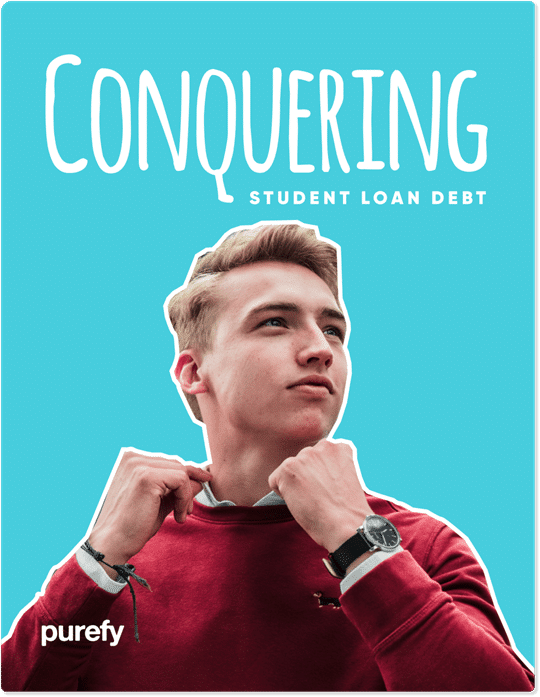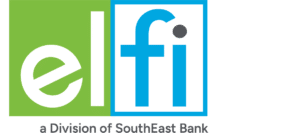Student loans are a real pain. There, we said it. The worst part? You could be making payments toward your debt for decades. Depending on the type of loans you have and your repayment term, you could be making payments well into your 30’s, 40’s, or even your 50’s.
However, it doesn’t have to be that way. If you’re sick of your debt and want to learn how to get rid of student debt fast, there are strategies you can use to save money and become debt-free.
Why it’s so important to pay off student loans as fast as possible
If you’re trying to figure out how to pay off college debt quickly, it can be a good idea to focus on the drawbacks of having loans to help you stay motivated. Paying off your student loans as quickly as possible is important for the following reasons:
Interest can accrue quickly
Student loan interest can accrue while you’re in school, during your grace period, and throughout your repayment term. Because interest is constantly accruing, your balance can grow over time. Depending on your balance and your interest rate, you could pay thousands more than you initially borrowed by the end of your repayment term. Paying off your loans more quickly helps reduce how much interest you have to repay.

Free eBook: How to Conquer Student Loans
Free eBook: How to Conquer Student Loans

They can prevent you from achieving other goals
Your loans can be a huge burden, and they can prevent you from being able to pursue other goals. Whether you want to buy a home, purchase a new car, or launch a business, having student loan debt can make it impossible to finance those dreams.
Student loans are nearly impossible to get discharged
Unlike other forms of debt, student loans are nearly impossible to get discharged in bankruptcy. Even if you get sick or have some other emergency that derails your finances, you’ll likely have to continue paying your student loans.
College debt can cause significant stress
Personal finance isn’t always about numbers and interest rates. It can also be about your mental health and emotions. If having debt causes you stress or anxiety, paying off your loans can improve your finances and your peace of mind.
You can free up cash flow
You likely pay hundreds each month toward your loans. If you eliminate your debt, you’d have that money every month to put toward other goals or interests. You could use it to pay travel, save for retirement, or simply enjoy more breathing room in your budget.
15 Ways to pay off student loans fast
If you want to pay off your debt, you can use these tips to pay off student loans fast.
1. Sign up for automatic payments
You likely have multiple student loans, all with their own due dates and payment minimums. If you try to make all of your payments manually, you risk making a mistake and missing one, damaging your credit.
Signing up for automatic payments ensures all of your payments are made on time. Plus, there’s an added bonus: most lenders offer automatic payment discounts. When you sign up for autopay, you can usually get a 0.25% interest rate discount. While that discount may sound small, it can add up to hundreds of dollars saved over the life of your loan.
2. Pay more than the minimum
Student loans are a form of installment debt. They have a pre-set repayment term, and your payments are determined by your interest rate and term. As long as you make all of your minimum payments on time, you’ll pay off the loan as scheduled.
However, your minimum payments are designed to last for the entire repayment term. If you want to pay off your loans faster, you must pay more than the minimum required.
Even small amounts can make a big difference. Below is how much quicker you’d pay off your loans — and how much money you’d save — by increasing your monthly payments. The examples below are based on $35,000 in student loans at 6% interest with a 10-year repayment term.
| Original Terms | Increasing Payment by $10 Per Month | Increasing Payment by $20 Per Month | Increasing Payment by $50 Per Month | |
| Monthly Payment | $389 | $399 | $409 | $439 |
| Time in Repayment | 120 months | 116 months | 108 months | 102 months |
| Time Saved | N/A | 4 months | 8 months | 18 months |
| Total Interest Cost | $11,610 | $11,185 | $10,791 | $9,762 |
| Total Saved | N/A | $425 | $819 | $1,848 |
3. Use the debt snowball method
If you’re like most borrowers and have multiple federal and private student loans, it can be difficult to know where to start. One popular debt payoff strategy is the debt snowball method. With this approach, you make a list of all of your existing student loans, ordering them from the one with the lowest balance to the one with the highest balance.
For example, you may have the following loans:
- $3,000 federal Unsubsidized Loans at 3.73%
- $6,000 federal Subsidized Loan at 2.75%
- $9,000 private student loan at 5%
Because the $3,000 loan is the smallest, you’d focus your attention on that loan. You continue making the minimum payments required on each loan every month. If you have any extra cash, you put it toward the $3,000 loan.
Once that loan is paid off, you roll over its minimum payment — and any extra you can afford — to the loan with the next smallest balance. You continue this process until all of your loans are paid off.
This debt repayment strategy is appealing to many because you can pay off some of your loans quickly. Reducing the number of loans you have can be highly motivating, helping you stay focused on your debt payoff journey.
4. Use the debt avalanche method
If you’re looking for the most effective ways to pay off student debt faster, the debt avalanche method may be a better fit for you than the debt snowball.
Like the debt snowball method, you’ll continue making the minimum payments on all of your loans and dedicate extra cash to one account. But instead of tackling the loan with the lowest balance first, the debt avalanche method recommends focusing on the loan with the highest interest rate since they’re the most expensive form of debt.
For example, if you had these loans, you’d tackle them in this order:
- $9,000 private student loan at 5%
- $3,000 federal Unsubsidized Loans at 3.73%
- $6,000 federal Subsidized Loan at 2.75%
Because the private student loan has the highest interest rate at 5%, that’s the loan you’d make extra payments on first. Once that loan was eliminated, you’d take that payment and roll it over to the loan with the next highest interest rate — the federal loan at 3.73%. Continue this process until all of your loans are gone.
The debt avalanche method doesn’t give you the quick wins of the debt snowball method since it focuses on interest rate rather than the lowest balance, but it’s more effective. By eliminating the highest interest debt, you’ll save more money and pay off your debt faster.
See How Much You Can Save
Student Loan Payoff Calculator
View Details
Collapse
Check how long it will take you to pay off your student loans. Quickly see the effects of lower rates, extra payments, and different terms on your repayment plan.
Results
| Current Payment | w/ extra payment | Difference | |
|---|---|---|---|
| Term | 10 years | — | — |
| Payoff Date | — | — | |
| Total Interest | $16,560 | — | — |
Want to lower your rate to help pay off student loans faster? Check your rate at our top-rated lenders in 2 minutes, with no impact on credit.
5. Trim your budget
To make extra payments toward your student loans, you may need to reduce your expenses. Carefully review your monthly budget and spending habits and look for areas that you can reduce or eliminate entirely.
Some common ways to lower your expenses include:
- Get a roommate: If you currently live alone, think about getting a roommate to split your rent and utilities. Since your housing expenses are typically the highest expense, a roommate can be an effective way to free up cash for student loan repayment.
- Cut subscriptions: You likely subscribe to more service than you think. Hulu, Netflix, Amazon Prime — all of those recurring subscriptions add up. Review your credit card billing statements and see what services you actually use and which ones you can cancel.
- Meal plan: When you’re hungry and tired, the last thing you want to do is stop at the grocery store and cook. But getting takeout or delivery can be expensive. You can save money by spending a little time on the weekends planning and preparing your meals for the week. Not sure where to start? The College Nutritionist has detailed meal prep plans and tips for college students and recent graduates.
- Carpool: You can lower your transportation expenses by carpooling to work. It reduces the wear and tear on your car, and you won’t have to spend so much on gas. If you don’t have a coworker that lives nearby, you may be able to find other local professionals to carpool with via Moovit or Rideshare.org.
- Shop around for insurance: Car insurance can be expensive. But if you haven’t shopped around for coverage, you could be wasting money. It’s a good idea to comparison shop for car insurance at least once per year. A useful resource is The Zebra; it allows you to compare options from multiple insurers at once.
- Switch to a different cell phone plan: Your smartphone plan could cost hundreds per month. Review your usage and consider what plan you really need, and, if possible, downgrade to a cheaper plan.
6. Ask your employer for repayment assistance
To recruit new college graduates and young professionals, many companies have launched their own student loan repayment programs. They typically function like 401(k)s; your employer will match your student loan payments up to an annual maximum, usually a percentage of your salary.
For example, if your employer matches 100% of your loan payments up to 5% of your salary and you earn $50,000 per year, the maximum your employer will match is $2,500 per year.
Talk to your human resources department to see if student loan repayment assistance is an available benefit. If it’s not, you can suggest it as a valuable tool to attract and retain top talent.
7. See if you’re eligible for student loan forgiveness
Depending on the type of student loans you have and your profession, you could be eligible for partial or full loan forgiveness.
If you have federal loans, you may qualify for one of the following programs:
- Public Service Loan Forgiveness (PSLF): PSLF is for workers employed by non-profit organizations or federal or state government agencies. After making payments for 10 years on a qualifying payment plan while working full-time for an eligible employer, the government will forgive your remaining loan balance.
- Teacher Loan Forgiveness: If you are a teacher of a high-need subject area and work in a low-income area, you could be eligible for up to $17,500 in loan forgiveness through the federal Teacher Loan Forgiveness program.
8. Use your tax refund to make a lump sum payment
According to the IRS, the majority of tax filers receive a tax refund. In 2021, the average refund was $2,850. Instead of using that money for a vacation or a new television, consider using it to pay off some of your student loans. The money will allow you to get out of debt faster, and you’ll save money on interest charges.
For example, Mary had $35,000 in student loans with a 10-year repayment term and a 6% interest rate. She received a tax refund of $2,850, and she used it to make a lump sum payment on her loans. By doing so, she pays her loan off 13 months early, and she saves $2,180.
9. Boost your income
To pay off your student debt as quickly as possible, you need to make extra payments. There is only so much you can trim your budget, so it’s important to think about ways to increase your income. Here are just a few easy to earn more cash:
- Ask for a raise: One of the quickest ways to earn more money is to ask your current employer for a raise. If you’ve been in your role for a while and have gotten good feedback, it may make sense to talk to your manager about boosting your compensation.
- Look for a new job: If a raise simply isn’t possible, consider looking for a new job. Switching jobs is often the only way to get a substantial pay increase, meaning a raise of 10% or more.
- Freelance or consult: If you have a skill that’s in demand, you can use your expertise to freelance or provide consulting services to small businesses.
- Clean houses: If you like cleaning, you can earn money cleaning houses through services like Handy.
- Do odd jobs: If you are a whiz at assembling furniture, wrapping presents, or decorating for the holidays, you can use those skills to earn money through apps like TaskRabbit.
10. Make bi-weekly payments
An easy way to pay off your loans a little faster is to make two payments per month instead of one. Just divide your minimum monthly payment into two and make payments every two weeks.
You’ll pay the same amount, but due to the number of weeks in a year, you’ll make one full extra payment per year.
11. Avoid alternative payment plans
For most student loans, the default repayment term is 10 years. However, there are ways to lengthen your repayment term if you’d like to get a smaller monthly payment. With income-driven repayment plans, you can extend your repayment term to 20 or 25 years, and extended repayment plans can be as long as 30 years.
While getting a lower payment can be tempting, the longer term means more interest will accrue over time. You will likely end up paying thousands more over the life of your loan with an alternative payment plan.
To avoid paying unnecessary dollars, don’t enroll in a longer payment plan.
The 2 Best Companies to Refinance Student Loans
Our Top-Rated Picks for 2024 Offer Low Rates and No Fees

12. Make payments during your grace period
With federal student loans and some private ones, you don’t have to make payments during the first six months after you graduate — your grace period. But depending on the type of loans you have, interest may continue to accrue during the grace period, causing your balance to grow.
To cut down on accrued interest and to pay off your loans faster, try to make payments during the grace period. Even small payments —- such as $25 per month — will reduce how much interest builds and save you more money over the long run.
13. Claim the student loan interest tax deduction
If you make payments toward your student loans, you could be eligible for the student loan interest tax deduction. You can deduct up to $2,500 or the actual amount of interest you paid, whichever is less.
The tax deduction can help reduce your tax bill and increase your tax refund, giving you more money for debt payments.
14. Find out if your state offers student loan repayment programs
Depending on where you live and your career path, you may be eligible for help with your student loans from your state or professional association. Several states offer repayment assistance programs to encourage people in high-need occupations to live and work in the state. Typically, these programs require you to work in areas that have designated shortages for a set term.
For example:
- Florida: The Florida Bar Foundation operates the Loan Repayment Assistance Program (LRAP) for legal aid staff attorneys that work for eligible legal assistance organizations. Qualifying attorneys can receive up to $5,000 in loan repayment help.
- Maine: If you’re a veterinarian in Maine, you can get up to $100,000 in student loan repayment assistance through the Maine Veterinary Medicine Loan Program. To qualify, you must work in a veterinary practice within the state in an area that has a shortage of veterinarians and treat livestock at least part of the time.
- New Jersey: New Jersey recently launched a new program for STEM — science, technology, engineering, and mathematics — workers. Qualifying professionals get up to $8,000 in student loan assistance through the STEM Loan Redemption Program.
- Oklahoma: Teachers of science and mathematics may qualify for the Oklahoma Teacher Shortage Employment Incentive Program. Through this program, eligible teachers can receive help with their existing student loans if they agree to teach for at least five years in a qualifying school. The amount of the repayment assistance varies each year.
- Oregon: In Oregon, some healthcare professionals can get up to $35,000 per year in student loan repayment assistance through the Oregon Partnership State Loan Repayment Program. In exchange, you must agree to work for at least two years in a designated health professional shortage area (HPSA).
To find out if your state offers a similar program for your profession, check with your state education agency, or visit your professional association’s website for more information.
15. Consider student loan refinancing
If you want to learn how to get rid of student debt fast, student loan refinancing is one of the most effective strategies.
If you have good credit and steady income, refinancing your loans could allow you to get a lower interest rate than you have now, and more of your monthly payment will go to the principal instead of interest charges. By refinancing your debt, you could save money and pay off your loans years ahead of schedule.
For instance, Harry graduated with $50,000 in student loans at 6.5% interest and a 10-year repayment term. He decided to refinance his debt and qualified for a 7-year loan at 4.75% interest.
Thanks to student loan refinancing, Harry saved over $9,000 and paid off his loans three years earlier.
| Original Loan at 6.5% Interest | Refinanced Loan at 4.75% Interest | |
| Loan Term | 10 Years | 7 Years |
| Monthly Payment | $568 | $701 |
| Total Interest | $18,129 | $8,870 |
| Total Paid | $68,129 | $58,870 |
| Total Saved: $9,249 |
Refinancing your student loans to pay off your debt faster
If you want to know how to get rid of student debt fast, refinancing your loans can be a useful strategy. To make sure you get the best interest rates and terms available, compare offers from multiple student loan refinancing lenders. With Purefy’s Compare Rates tool, you can get rate quotes from top lenders with just one simple form and no credit checks.



















